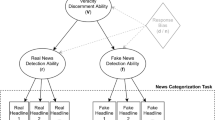Abstract
Two studies were conducted with the aim of demonstrating anchoring induced biases in consumer price negotiations.
In Study 1, 96 undergraduate students of business administration who were recruited as subjects played the role of buyers of a condominium. All subjects were given the same market information. They were then asked to state whether their reservation price was higher or lower than an arbitrary price example (irrelevant anchor) that for different groups of subjects was either low or high. Finally, subjects indicated their reservation price. As would be predicted if adjustments from the anchor are insufficient, the indicated reservation price was lower when the anchor was low than when it was high.
In Study 2, employing 64 undergraduate students of psychology who conducted dyad negotiations about the price of condominiums, the effect of the irrelevant anchor on the initially indicated reservation price was replicated. In addition, an anchoring effect of the seller's initial offer was observed. The results also revealed effects of both irrelevant anchor and initial offer on the purchase price.
From a public policy point of view, the results imply that consumers may be strongly influenced by irrelevant anchors provided by sellers. Provision of accurate market price information may however lessen the impact of irrelevant anchors.
Similar content being viewed by others
REFERENCES
Blount, S., Thomas-Hunt, M. C., & Neale, M. A. (1996). The price is right-or is it? A reference point model of two-party negotiations. Organizational Behavior and Human Decision Processes, 68, 1–12.
Camerer, C. F. (1989). An experimental test of several generalized utility theories. Journal of Risk and Uncertainty, 2, 61–104.
Camerer, C. F., & Hogarth, R. M. (1999). The effects of financial incentives in experiments: A review and capital-labor-production framework. Journal of Risk and Uncertainty, 19, 7–42.
Chapman, G. B., & Johnson, E. J. (1994). The limits of anchoring. Journal of Behavioral Decision Making, 7, 223–242.
Gärling, T., & Friman, M. (in press). A psychological conceptualization of residential choice and satisfaction. In: J. Aragonés, G. Francescato, & T. Gärling (Eds.), Residential environments: Choice, satisfaction, and behavior. Westport, CT: Greenwood.
Güth, W. P., Schmittberger, P., & Schwarze, B. (1982). An experimental analysis of ultimatum bargaining. Journal of Economic Behavior and Organizations, 3, 367–388.
Hogarth, R. M., & Einhorn, H. J. (1990). Venture theory: A model of decision weights. Management Science, 36, 780–803.
Jacowitz, K. E., & Kahneman, D. (1995). Measures of anchoring in estimation tasks. Personality and Social Psychology Bulletin, 21, 1161–1166.
Kahneman, D. (1992). Reference points, anchors, norms, and mixed feelings. Organizational Behavior and Human Decision Processes, 51, 296–312.
Kahneman, D., & Tversky, A. (1979). Prospect theory: An analysis of decision under risk. Econometrica, 47, 263–291.
Kristensen, H., & Gärling, T. (1997a). Adoption of cognitive reference point in negotiations. Acta Psychologica, 97, 277–288.
Kristensen, H., & Gärling, T. (1997b). Determinants of buyers' aspiration and reservation price. Journal of Economic Psychology, 18, 487–503.
Kristensen, H., & Gärling, T. (1997c). The effects of anchor points and reference points on negotiation process and outcome. Organizational Behavior and Human Decision Processes, 71, 85–94.
Kristensen, H., & Gärling, T. (2000). Anchor points, reference points, and counteroffers in negotiations. Group Decision and Negotiation, 9, 493–505.
Kühberger, A. (1998). The influence of framing on risky decisions: A meta-analysis. Organizational Behavior and Human Decision Processes, 75, 23–55.
Lindberg, E., Gärling, T., & Montgomery, H. (1989). Belief-value structures as determinants of consumer behavior: A study of housing preferences and choices. Journal of Consumer Policy, 12, 119–137.
Neale, M. A., & Bazerman, M. H. (1991). Cognition and rationality in negotiation. New York: Free Press.
Neale, M. A., & Northcraft, G. B. (1991). Behavioral negotiation theory: A framework for conceptualizing dyadic bargaining. In L. J. Cummings & B. M. Staw (Eds.), Research in organizational behavior, Vol. 13, pp. 147–190. Greenwich, CT: JAI Press.
Northcraft, G. B., & Neale, M. A. (1987). Expert, amateurs, and real estate: An anchoring-and-adjustment perpective on property pricing decisions. Organizational Behavior and Human Decision Processes, 39, 228–241.
Payne, J. W., Bettman, J. R., & Johnson, E. J. (1993). The adaptive decision maker. New York: Cambridge University Press.
Pinkley, R. L., Neale, M. A., & Bennett, R. J. (1994). The impact of alternatives to settlement in dyadic negotiation. Organizational Behavior and Human Decision Processes, 57, 97–116.
Raiffa, H. (1982). The art and science of negotiation. Cambridge, MA: Harvard University Press.
Ritov, I. (1996). Anchoring in simulated competitive market negotiation. Organizational Behavior and Human Decision Processes, 67, 16–25.
Simon, H. A. (1990). Invariants of human behavior. Annual Review of Psychology, 41, 1–19.
Slovic, P., & Lichtenstein, S. (1971). Comparison of Bayesian and regression approaches to the study of information processing in judgement. Organizational Behavior and Human Performance, 6, 649–744.
Thompson, L. (1990). Negotiation behavior and outcomes: Empirical evidence and theoretical issues. Psychological Bulletin, 108, 515–532.
Tversky, A., & Kahneman, D. (1974). Judgement under uncertainty: Heuristics and biases. Science, 185, 1124–1131.
Tversky, A., & Kahneman, D. (1991). Loss aversion in riskless choice: A referencedependent model. Quarterly Journal of Economics, 106, 1039–1061.
Walton, R. E., & McKersie, R. B. (1965). A behavioral theory of labor relations. New York: McGraw-Hill.
White, S. B., & Neale, M. A. (1991). Reservation price, resistance point, and BATNAs: Determine the parameters of acceptable negotiated outcomes. Negotiation Journal, 7, 379–388.
White, S. B., Valley, K. L., Bazerman, M. H., Neale, M. A., & Peck, S. R. (1994). Alternative models of price behavior in dyadic negotiations: Market prices, reservation prices, and negotiator aspirations. Organizational Behavior and Human Decision Processes, 57, 430–447.
Whyte, G., & Sebenius, J. K. (1997). The effect of multiple anchors on anchoring in individual and group judgement. Organizational Behavior and Human Decision Processes, 69, 75–85.
Author information
Authors and Affiliations
Rights and permissions
About this article
Cite this article
Kristensen, H., Gärling, T. Anchoring Induced Biases in Consumer Price Negotiations. Journal of Consumer Policy 23, 445–460 (2000). https://doi.org/10.1023/A:1007280722313
Issue Date:
DOI: https://doi.org/10.1023/A:1007280722313




